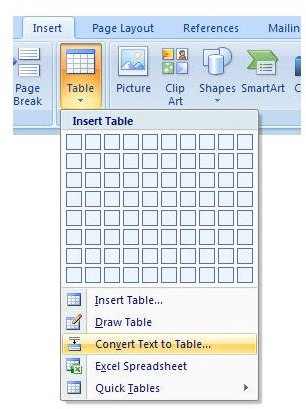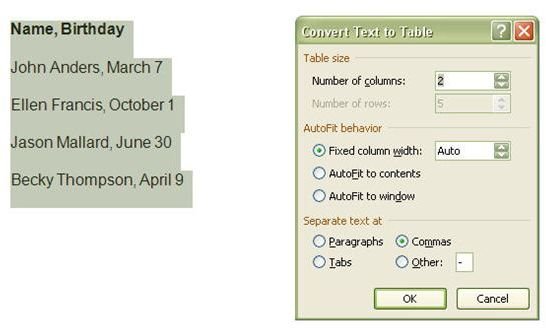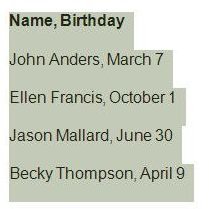How to Convert Text to a Table in Microsoft Word 2007 – Automatically Change Lists to Tables
Have you ever gotten half-way through typing up a long list in a Microsoft Word document, and then thought the information would look better presented in a table? If so, you don’t have to start all over by creating a new table and re-entering your data. Microsoft Word 2007 has a feature that allows you to convert existing text into a table layout that you can then modify and format as much as you like.
Converting Text to a Table
Let’s suppose that we were creating a birthday list in Microsoft Word, and after making a few entries, we decided we wanted to convert that list into a table. The first thing we want to do is select all of the text that we want the table to include. (Click the following image for a larger view.)
Next, open the Insert tab on the Word ribbon. From the Table dropdown menu, select Convert Text to Table.

This action will open a dialog box asking for more information about your table construction. The options here will be prefilled with Word’s best “guesses” on how you want the table layout to appear, but these guesses often need to be modified. First double check to make sure that the proper number of columns has been chosen. In our example, we want two columns – one for name and one for birthday. Also make sure that the proper character has been chosen for the Separate text at field. We used a comma for our birthday list, so we’ll select that option.

Note: The Convert Text to Table feature works better with some separators (or delimiters) than others. In general, it’s best to try and stay away from using tabs and spaces to separate your data if you want to use this feature. Otherwise, you’ll end up having to do a lot of additional formatting, and that defeats the purpose of using this shortcut method in the first place. Characters such as commas and semi-colons work much better.
After you’ve finished making modifications, click OK to continue. The data will now be converted to table form in your Word document as shown in the following image.

While this table does look a lot nicer than our original list, it would look even better with some formatting and design applied to it. In the next article of this series, we’ll talk more about how you can “pretty up” a table in Microsoft Word.
This post is part of the series: Using Tables and Charts in Microsoft Word 2007
In this series, we’ll take a look at how charts and tables can be used in Microsoft Word 2007 documents to help illustrate important concepts and keep the reader’s attention.
